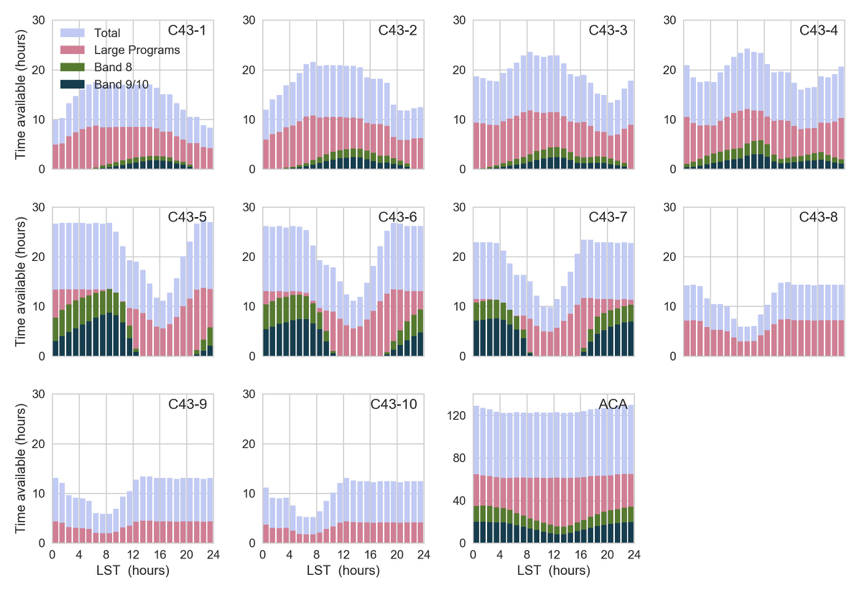Additional Information for Cycle 6 Proposals
As indicated in the Cycle 6 Pre-announcement, this announcement provides further information on Cycle 6 proposals, including:
- Cycle 6 configuration schedule
- Planning Large Programs
- Circular polarization,
Complete details will be provided in the Call for Proposals, which will be released on the ALMA Science Portal on March 20, 2018.
1. Cycle 6 configuration schedule
Table 1 summarizes the anticipated configuration schedule for Cycle 6. The table includes the start date of the configuration, the longest baseline, and the LST range with the best atmospheric stability, which is approximately from 2 hours after sunset to 4 hours after sunrise. The configuration schedule may be modified based on the Cycle 6 proposal pressure. The Cycle 6 antenna configuration files needed for CASA simulations are available on the Science Portal.
| Table 1: Cycle 6 configuration schedule | |||
|
Start date |
Configuration |
Longest baseline |
LST for best observing conditions |
|
2018 October 1 |
C43-6 |
2.5 km |
~ 22h – 10h |
|
2018 October 15 |
C43-5 |
1.4 km |
~ 0h – 12h |
|
2018 November 25 |
C43-4 |
0.78 km |
~ 2h – 14h |
|
2018 December 15 |
C43-3 |
0.50 km |
~ 4h – 15h |
|
2019 January 5 |
C43-2 |
0.31 km |
~ 5h – 16h |
|
2019 January 20 |
C43-1 |
0.16 km |
~ 6h – 17h |
|
2019 February 1-28 |
No observations due to February shutdown |
||
|
2019 March 1 |
C43-1 |
0.16 km |
~ 8h – 21h |
|
2019 March 15 |
C43-2 |
0.31 km |
~ 8h – 22h |
|
2019 April 1 |
C43-3 |
0.50 km |
~ 9h – 23h |
|
2019 April 15 |
C43-4 |
0.78 km |
~ 10h – 0h |
|
2019 May 1-31 |
No observations due to major antenna relocation |
||
|
2019 June 1 |
C43-10 |
16.2 km |
~ 13h – 3h |
|
2019 June 20 |
C43-9 |
13.9 km |
~ 14h – 5h |
|
2019 July 10 |
C43-8 |
8.5 km |
~ 16h – 6h |
|
2019 August 1 |
C43-7 |
3.6 km |
~ 18h – 8h |
|
2019 September 5 |
C43-6 |
2.5 km |
~ 20h – 9h |
2. Planning Large Programs
Up to 15% of the time in Cycle 6 may be allocated to Large Programs; i.e., 600 hours for the 12m Array and 450 hours for ACA stand-alone. The definition of Large Programs and the evaluation criteria in Cycle 6 will be the same as in Cycle 5.
To optimise the success in completing the observations within Cycle 6, the following scheduling constraints will be imposed when selecting Large Programmes: (1) the time allocated to Large Programs will not exceed 33% of the available time for a given Local Sidereal Time (LST) range on antenna configurations with baselines longer than 12 km (configurations C43-9 and C43-10), and (2) the time allocated to Large Programs will not exceed 50% of the available time for a given LST range on configurations with baselines shorter than 12 km (ACA and C43-1 to C43-8).
The amount of time suitable for observations in an ALMA receiver band depends on the atmospheric precipitable water vapor (PWV) and phase stability. The weather conditions exhibit both diurnal and annual variations, with the lowest average PWV and best atmospheric stability occurring at night between May and November.
Figure 1 shows the percentage of time when the PWV is below the thresholds adopted for the various ALMA bands. Figure 2 shows the expected amount of time available versus LST in the ALMA Cycle 6 configurations after factoring in scheduled maintenance and other observatory activities.
Figure 1: Box and whisker plots of the percentage of time that the precipitable water vapor (PWV) is less than the thresholds adopted for the various ALMA bands versus the month of the year. Results are shown for both night time (green) and mid-afternoon (yellow), and assume a source elevation of 60 degrees. The horizontal line within a box indicates the median, the boundaries of a box indicate the 25th- and 75th -percentile of the distribution, and the whiskers indicate the highest and lowest values of the distribution. The PWV measurements were obtained by the APEX weather stations between 2007 and 2017.
Figure 2: Effective observing time available per configuration for executing PI projects (blue). As an example, up to 10 hours may be allocated to Large Programs in configuration C43-2 at LST = 10 h. The total number of hours excludes time spent on observatory calibrations, maintenance, and antenna relocations. The amount of time available for Large Programs and high frequency observations are also indicated. The data files containing these histograms are available here.
3. Circular polarization
As indicated in the Cycle 6 pre-announcement, circular polarization for both continuum and full-spectral-resolution observations in Band 3, 4, 5, 6, and 7 are offered on the 12-m Array. The minimum detectable degree of circular polarization, defined as three times the systematic calibration uncertainty, is currently 1.8% of the peak flux for both TDM and FDM observations. Circular polarization will be offered only for sources that are on-axis with an angular size less than 10% of the FWHM primary beam. This field-of-view constraint supersedes the Cycle 6 pre-announcement.


